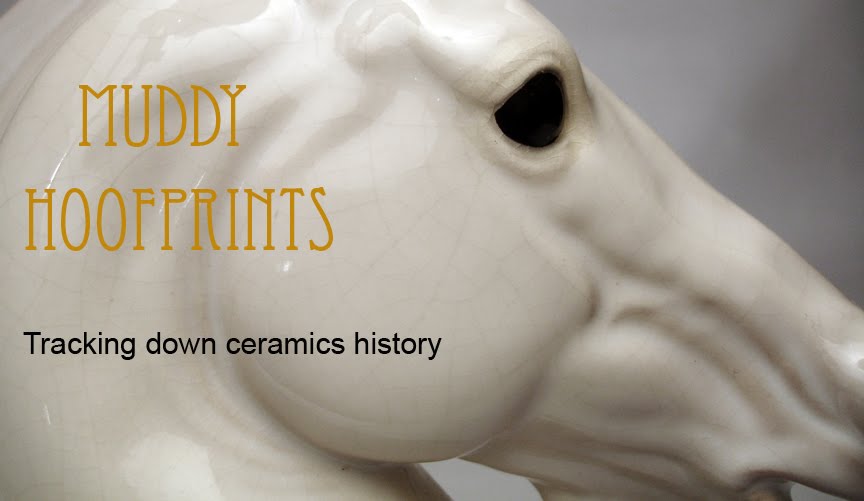1. The room needs to be darkened for the effect (fluorescing) to even be visible. Pretty dark, darker than any show hall ever was.
2. It only fluoresces on certain materials, but not the ones most commonly on the surface.
3. Known restorations did not show up at all in the UV BLB beam.
I had purchased actual black light flashlights (UV BLB) for my judges to use at Clinky Classic 5. These were not cheap fakes. I even tested them in non-ceramics applications and found them to work perfectly, prior to the show. However, on restored ceramics, I (and several witnesses) saw that the restored models did not fluoresce. Only models in the midst of restoration, with unpainted epoxy patches or other exposed adhesives, showed any fluorescence.
Items that are painted with oils can show up under UV black light. However, this is less common than using acrylics, and thus the black light is not a practical tool in finding repairs or cosmetic enhancements on ceramic models. It's pretty darn useless.
Here is an example of a readily-visible unpainted ear tip repair in raw epoxy, on my Swaps. It is quite noticeable to the naked eye in the normal spectrum.
Under UV BLB, that ear glows! White pigments do, too, hence the bright star. The star is original glaze.
Another example of raw epoxy, although not fluorescing as brightly. Man O' War model courtesy Jennifer Dodd.
Under normal spectrum lighting, this acrylic-painted restored ear tip (on Left) is just barely visible to the naked eye. It is a slightly colder gray.
Under UV BLB, it looks no different than the original ceramic ear. The acrylic paint has masked the repair; it is not a fluorescing material.
Now, it gets even more complicated, and disheartening.
That Miss Pepper's entire hind leg is a restoration. She had no leg, and a missing ear tip (model courtesy Ed Alcorn). If UV BLB was useful for identifying restorations, that non-ceramic leg and ear should be lit up like a co-ed at a rave.
Since the epoxy is covered with acrylic paint, and the acrylics are themselves coated with non-fluorescing sealers, it appears like normal ceramic, under black light.
A former gnarly break, restored, and invisible both to the naked eye under normal spectrum, and invisible under black light.
This Two Bits' ear and part of his cranium had been broken off and glued back on, at one time. It is now an invisible repair. Under UV BLB, even from two different angles of black light beam, it remains invisible.
These are just a handful of examples showing how such major changes can be imperceptible by black light method. It follows that any cosmetic enhancement would be hidden, as well. Thus, as sellers and buyers, we must use our eyes and records to avoid pitfalls. Reliance on the black light could lead to misrepresentation of sales items and show horses, and then some angry chargebacks or negative feedback.
I later found this government document which expands on the invisible-to-UV black light repair situation.
As much as black lights have been touted as the last word in identifying fakes, restorations, and cosmetic enhancements to artifacts, it is time to drop any remaining reliance on them as an evaluation tool. Although there is no magic tool, the normal lighted magnifiers are helpful in finding restoration brushstrokes or different airbrush spray. Now, if a seller says they used a black light to verify condition, I become wary and inclined to turn away. If collectors continue to rely on the black light for identifying restorations, they will be left in the dark.
















can you explain what 'enhancing' is if it is different than a repair? Thanks
ReplyDeleteEnhancement is an improvement of the item, above and beyond original factory condition. It used to be standard practice in the model horse hobby to correct factory errors and glaze imperfections, and then resell the items with unclaimed or forgotten changes. A more sinister enhancement is that of adding shading to improve a model's chances in the market and in the show ring. This practice has not ceased, it's just kept quieter, now. I discovered enhancements when restoring two models last year, alone. One was to hide a factory marking and to alter the glaze finish (semigloss to matte), so the piece appeared to be a rare variant (thus more competitive). The other was enhanced with shading that was not applied at the factory. At the time it was applied, normalcy was the goal, and today, with the enhancement removed, it is actually a rare example. I once saw a judge call out an OF china entry that had all-over enhanced body shading. The last example had been done contemporary to that show, for the purpose of a showing edge. As a restorer, I have been asked to cosmetically enhance pieces. It is my feeling that once the glaze fire clicks off, anything that happens after that liquid-glaze moment is acquired damage. Anything prior to that is factory process, good or bad, and I am not in the business of hiding factory flaws. It's about restoring to factory condition, not improving factory condition.
ReplyDelete